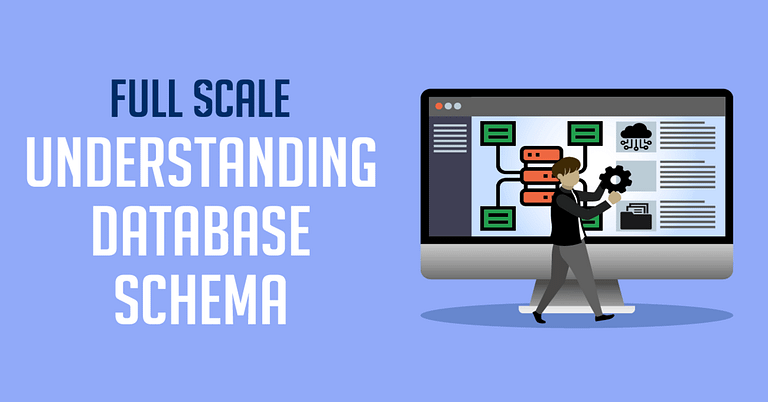Last Updated on 2024-10-11
Are you familiar with database schema? Halfway into 2023, adopting an efficient database management system is increasingly important. And database schema is your ticket to do so.
A well-designed database schema is the backbone for effectively organizing and structuring your data. And it is increasingly apparent for businesses and developers alike to employ it.
In this article, let’s explore the concept of a database schema, its fundamental components, its types, and its importance.
We will also talk about practical insights into designing a robust database schema and outline the best practices to ensure optimal performance and data integrity.
But, First, What Is Database Schema?
A database schema is an integral part of database design.
It’s a logical blueprint that defines a database’s structure, organization, and relationships. It encompasses the tables, columns, data types, constraints, and relationships between entities.
The database schema acts as a roadmap for storing, retrieving, and managing data in a consistent and organized manner. By defining the structure of your database, the schema ensures data integrity and facilitates efficient data access and manipulation.
Here Are the Fundamental Components of A Database Schema
Utilizing the schema makes it easier to query and update your data. But for it to work, its fundamental components, listed below, must function properly first.
- Table—It’s the primary building block of a database schema. It stores data in rows and columns.
- Column—Also known as a field, it defines the specific data elements or attributes that can be stored within a table.
- Data Type—Specifies the nature of the data stored in each column, such as integers, strings, dates, or booleans.
- Constraints—Enforce rules and restrictions on the data stored in your database. Among its examples are primary keys, foreign keys, and unique constraints.
- Relationships—It establishes connections and associations between tables, ensuring data consistency and integrity. Common types of relationships include one-to-one, one-to-many, and many-to-many.
5 Reasons Why Database Schema Is Important
Database schema design plays a crucial role in efficient data management. Here’s why it is essential.
- Enables you to organize data efficiently. A well-designed database schema structurally organizes your data. It facilitates easy access, retrieval, and manipulation of information.
- Reinforces data integrity. Proper schema design enforces constraints and relationships, preventing inconsistent and invalid data from entering the database. This promotes data integrity and reliability.
- Optimizes database performance. By considering performance factors during schema design, such as indexing and partitioning, you can enhance the query execution speed. This can lead to better overall system performance.
- Increases scalability and flexibility. A carefully designed schema allows for future scalability. It helps you accommodate the growth of data volumes and evolving business requirements. You can also increase flexibility to modify and extend the schema as needed.
- Refines collaboration and understanding. A well-documented schema aids in collaboration among developers, database administrators, and stakeholders. It ensures a common understanding of the database structure and facilitates effective team communication.
The Common Types of Database Schema
There are different types of database schemas based on the organization and structure of your data. The ones below are some of the commonly used types today.
Hierarchical Schema
In a hierarchical schema, data organization is likened to a tree-like structure with parent-child relationships. It is mainly used in hierarchical databases.
Network Schema
Network schemas also involve a hierarchical structure but with the ability to establish many-to-many relationships between entities. It was commonly used in network databases.
Relational Schema
Based on the relational model, relational schemas are widely used in relational database management systems (RDBMS). Tables and relationships between them form the foundation of this schema type.
Entity-Relationship (ER) Schema
Entity-relationship schemas are graphical representations that depict entities, attributes, and relationships in a database. They aid in designing and communicating the structure of a database.
Star Schema
Star schemas are commonly used in data warehousing. They involve a central fact table surrounded by multiple dimension tables, simplifying complex data analysis.

How to Design A Great Database Schema
Now that you know its basics, you can think about your database schema design. To kickstart your process, here are some steps you can follow.
- Analyze your database requirements. Understand the needs and objectives of your system. Identify entities and their relationships, and determine the data attributes and constraints.
- Brainstorm your conceptual design. Create an ER diagram to visualize entities, attributes, and relationships. This step helps you determine critical entities, their attributes, and the cardinality of relationships.
- Build a logical design. Translate your concepts into a logical schema. Start to define your tables, columns, relationships, and constraints. And don’t forget to normalize your data to reduce redundancy and improve your data integrity.
- Decide on your physical design. Consider physical implementation aspects, such as storage structures, indexing strategies, and partitioning methods. Moreover, think about hardware and system constraints for optimal performance.
- Conduct testing and iteration. Test your schema design using sample data. Perform necessary modifications based on feedback and performance evaluation.
7 Best Practices for Database Schema Design
How to optimize your database schema? Consider applying these best practices to your process.
- Analyze and normalize your data—Perform thorough data analysis to identify entities, attributes, and relationships. Normalize the schema to minimize redundancy and improve data integrity.
- Establish proper relationships—Define relationships between tables using primary and foreign keys to maintain data consistency and integrity.
- Use appropriate data types—Choose suitable data types for your columns. Why? Because it increases efficiency in data storage and retrieval while minimizing storage space requirements.
- Continuously optimize for query performance—Create indexes on columns frequently used in queries to enhance search and retrieval speed. Regularly analyze and optimize queries for better performance.
- Consider scalability and future growth—Anticipate future data growth and other complex business requirements. Employ techniques like partitioning and sharding to distribute data and improve performance.
- Schedule your maintenance and monitoring regularly—Perform regular maintenance tasks such as index reorganization, query optimization, and database tuning. Monitor performance metrics to identify and address potential data privacy and other issues.
- Remember to document and communicate—Maintain comprehensive schema documentation, including schema diagrams, relationships, and constraints. Share this documentation with relevant stakeholders to ensure clarity and effective collaboration.
Database Schema Is Your Best Friend In Database Management
Investing time and effort in a good database schema design ultimately leads to a more efficient and reliable database management system. Remember that a well-designed database schema is a critical foundation for efficient data management and storage.
So, are you ready to design robust database schemas? It may seem like a complex process. But with our best practices, your system can accommodate scalability, adapt to evolving business needs, and maximize the potential of its data resources.
Full Scale Can Help You
We can help you with your database management and software needs. At Full Scale, we can help you build a software development team quickly and affordably.
With our platform, outlining your requirements takes just two minutes. Once completed, our system will promptly connect you with suitable resources from our available talent pool.
Furthermore, we incorporate cutting-edge technologies into our projects. In addition, our user-friendly dashboard, specifically designed for clients, simplifies the management of your offshore team.
Work With Us On Your Development Project!

Matt Watson is a serial tech entrepreneur who has started four companies and had a nine-figure exit. He was the founder and CTO of VinSolutions, the #1 CRM software used in today’s automotive industry. He has over twenty years of experience working as a tech CTO and building cutting-edge SaaS solutions.
As the CEO of Full Scale, he has helped over 100 tech companies build their software services and development teams. Full Scale specializes in helping tech companies grow by augmenting their in-house teams with software development talent from the Philippines.
Matt hosts Startup Hustle, a top podcast about entrepreneurship with over 6 million downloads. He has a wealth of knowledge about startups and business from his personal experience and from interviewing hundreds of other entrepreneurs.





